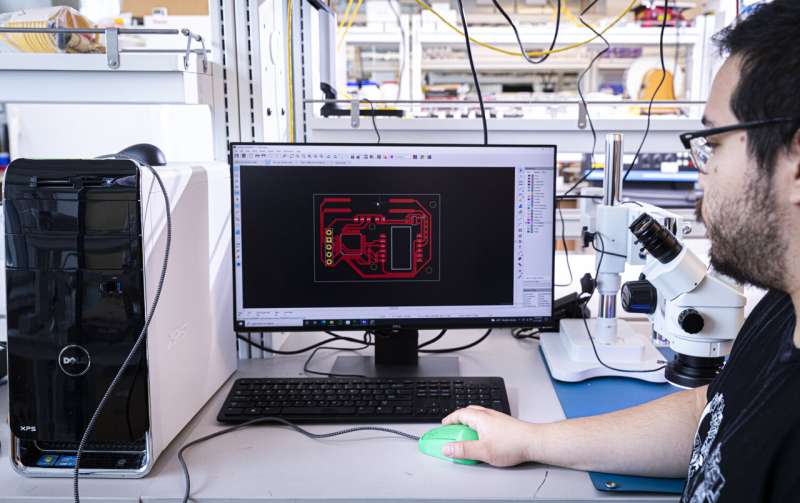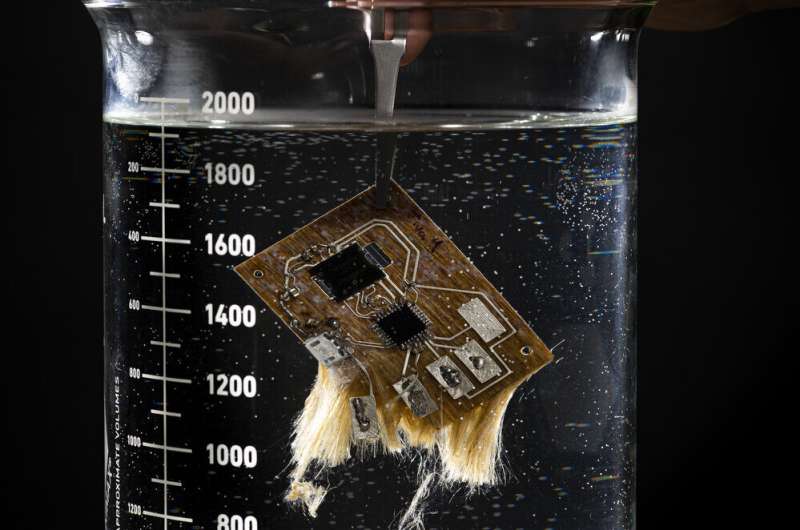Q&A: Making Earth-friendly electronics
The very components that make electronics fast and easy to use also make their disposal an environmental nightmare. Components of smartphones, computers and even kitchen appliances contain heavy metals and other compounds that are toxic to us and harmful to ecosystems.
As electronics become cheaper to buy, e-waste has piled up. A 2019 report from the World Economic Forum called e-waste “the fastest-growing waste stream in the world”—and for good reason. That same year, people generated more than 50 million metric tons of e-waste, according to the U.N.’s Global E-waste Monitor. Much of it is incinerated, piled up in landfills or exported to lower-income countries where it creates public health and environmental hazards.
Three researchers in the University of Washington College of Engineering are exploring ways to make electronics more Earth-friendly. Vikram Iyer, an assistant professor in the Paul G. Allen School of Computer Science & Engineering and researcher in the UW Institute for Nano-engineered Systems, will be presenting a functional computer mouse with a biodegradable case and circuit board at the CHI 2022 conference in May. Aniruddh Vashisth, an assistant professor of mechanical engineering, is creating synthetic materials that—unlike plastics—can be recycled and reused indefinitely. And Eleftheria Roumeli, an assistant professor of materials science and engineering and researcher in the Molecular Engineering & Sciences Institute, uses biological materials, such as seaweeds and other algae, to develop alternatives to plastics that can be 3D-printed.
For Earth Day, UW News reached out to these engineers to discuss their projects.
What features do you prioritize when designing sustainable electronics?
Vikram Iyer: There are lots of important problems to tackle in designing sustainable electronics, including reducing the environmental impact of e-waste. Our groups are trying to develop creative solutions to this problem, such as using new and more environmentally friendly materials while building functional devices that don’t compromise performance. For example, the mouse we designed with a biodegradable circuit board works when you plug it into any computer.
What was the design process like for the mouse?
VI: This project was a collaboration with Bichlien Nguyen, a principal researcher at Microsoft, and Vicente Arroyos, a UW doctoral student in the Allen School. We took several steps to make this mouse:
- We optimized our circuit design to use the fewest number of silicon chips possible, because around 80% of carbon emissions associated with manufacturing electronics comes from the energy-intensive processes used to make chips.
- We use biodegradable materials when possible. For example, the circuit board that holds and connects the chips together typically contains toxic flame-retardants, but we instead pattern our circuits on a board made from flax fibers. Also, the casing for the mouse is made out of biodegradable plastics.
- We use general-purpose, programmable chips, like microcontrollers, in our designs so that we can reuse them in new devices.
- We use software to estimate the environmental impact of each stage of production to quantify the environmental impacts and identify which stages of our design to improve next.
This is just a start, and our long-term vision is to develop new materials and methods that help us generate a production cycle for electronics in which all the materials and components can either be recycled and reused, or degraded and regenerated through the natural biological cycle.

Is it really true that the mouse’s case and circuit board dissolve in water?
VI: When we submerge our circuit board in water, the fibers start to come apart and the whole thing just disintegrates. This takes about five to 10 minutes in hot water, or a few hours at room temperature. After this we’re left with the chips and circuit traces which we can filter out. We also designed two different cases, one of these can dissolve in water and the other can be commercially composted.
Would a biodegradable mouse be as durable as a conventional mouse, especially up against the body heat and moisture we produce?
VI: There are definitely sustainable methods to ensure biodegradable components are also durable. For example, you could add a thin coating of water-repellent materials to the mouse—like chitosan, which is found naturally in the outer skeleton of shellfish. We also show that we can print the case out of polylactic acid, a material commonly used to make things like commercially compostable forks. Going forward we’re really excited to partner with researchers like Eleftheria, whose group is making new sustainable materials. And by partnering closely with researchers at Microsoft, we hope to develop solutions that are scalable and deployable for industry.
What types of new materials is the Roumeli group working on?
Eleftheria Roumeli: Our group focuses on developing materials derived from biological matter. In addition to seaweeds and other forms of algae, this includes plant residues and microbial products. Our studies aim to further our understanding of how these natural, versatile materials can be used as composite building blocks for sustainable alternatives to plastics.
How do you manufacture sustainable components—like biodegradable parts—for electronics?
ER: The great thing is that today’s manufacturing methods can be used to create sustainable components for electronics. For example, some of the biologically derived materials my group works with can be made into inks and filaments for manufacturing parts using 3D printing. We recently published a paper describing inks we developed from spirulina cells—that’s a type of blue-green algae—both with and without cellulose fibers as a filler. Cellulose is the most abundant natural polymer, and these inks are 100% compostable in soil. There’s no special composting facility required!
What are other alternative filaments you can use for 3D printing?
ER: We can also make hybrid materials that are a blend of both biological matter—such as spirulina cells—and commercial, degradable polymers. For the polymer, we use matrix materials such as polylactic acid, which Vikram mentioned before and is the most widely available industrially compostable polymer, or polybutylene adipate co-terephthalate, a soil-compostable polymer. The particular choice of components determines the properties, performance and the compostability of our filaments.

For example, for packaging, which we usually buy and “consume” very fast and then discard immediately, a material made solely of biological components would be preferable. Then, after we use it, it could be disposed of in a backyard or landfill and it would degrade in a few weeks.
But if we want a filament for the most common type of 3D printer, we would need a polymer binder to ensure that the filament meets the requirements of hot-extrusion based printing.
Are there any other new innovations for sustainable electronics?
Aniruddh Vashisth: One thing we’re working on is recyclable synthetic polymers. Unlike what Eleftheria’s team studies, these polymers are not derived from biological components. Instead, these polymers consist of an adaptive network and can be recycled and reprocessed multiple times.
Unlike other plastics, these materials do not lose their thermo-mechanical properties during reprocessing and recycling. This is exciting since you can reuse the same material again and again! This phenomenon of retaining material properties is possible because the building blocks that make up these materials can detach and reattach, just like Legos.
So when we are recycling, we are disassembling and reassembling the Legos. We have been focusing on aerospace-grade composites, but we are starting to explore other applications with a wide range of target applications.
What impact would that have on the e-waste problem?
AV: Today’s e-waste is usually a complex composite, with plastics, metal and ceramic components all in the same device. Recycling these materials is a challenging task, so they often just end up in landfills and lead to pollution.
Right now there are more than 250 million computers and 7 billion phones in the world. Most of these have polymer components. Just think if the polymers used in these devices could be recycled multiple times. That would be a great step toward sustainability! Our group has been working on how to design and characterize such recycled polymer composites for a more sustainable future.
Citation:
Q&A: Making Earth-friendly electronics (2022, April 21)
retrieved 21 April 2022
from https://techxplore.com/news/2022-04-qa-earth-friendly-electronics.html
This document is subject to copyright. Apart from any fair dealing for the purpose of private study or research, no
part may be reproduced without the written permission. The content is provided for information purposes only.
For all the latest Technology News Click Here
For the latest news and updates, follow us on Google News.
